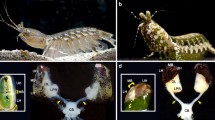Summary
An analysis of fine structure and function was conducted on three types of receptors in the cerebral vesicle of two species of ascidian tadpoles (Ciona intestinalis andDistaplia occidentalis). Theocellus is composed of one pigmented, cup-shaped supportive cell, an estimated 15–20 sensory cells, and three lens cells, each with a large body of granules (glycogen ?). The outer segments of the photoreceptoral processes are modified cilia, one per sensory cell, consisting of many lamellae, formed by infoldings of the ciliary membranes, and axonemes of 9 + 0 doublets of microtubules. The lamellae are homologous to retinal disks of vertebrates.Hydrostatic pressure (?)receptors are modified cilia containing tubules which open to the lumen of the cerebral vesicle. These receptors closely resemble the globular, ciliary processes of coronet cells in the saccus vasculosus of fishes. Thestatocyte is a onecell gravity receptor. The part extending into the lumen of the brain contains the nucleus and a large black body which is thought to function as a float. The foot-piece of the cell is firmly anchored in the brain wall; the neck is probably the site of generation of signals.
Similar content being viewed by others
References
Bargmann, W., Knoop, A.: Weitere Studien am Sacous vasculosus der Fische. Z. Zellforsch.55, 577–596 (1961).
Barnes, S. N.: The fine structure of the photoreceptor of the ascidian,Amaroucium constellatum. Biol. Bull.137, 392 (1969).
Cloney, R. A.: Cytoplasmic filaments and cell movements: epidermal cells during ascidian metamorphosis. J. Ultrastruct. Res.14, 300–328 (1966).
de Robertis, E.: Electron microscope observations on the submicroscopic organization of the retinal rods. J. biophys. biochem. Cytol.2, 319–330 (1956).
Dilly, P. N.: Electron microscope observations of the receptors in the sensory vesicle of the ascidian tadpole. Nature (Lond.)191, 786–787 (1961).
—: Studies on the receptors in the cerebral vesicle of the ascidian tadpole. 1. The otolith. Quart. J. micr. Sci.103, 393–398 (1962).
—: Studies on the receptors in the cerebral vesicle of the ascidian tadpole. 2. The ocellus. Quart. J. micr. Sci.105, 13–20 (1964).
—: The ultrastructure of the test of the tadpole larva ofCiona intestinalis. Z. Zellforsch.95, 331–346 (1969a).
—: Studies on the receptors inCiona intestinalis. III. A second type of photoreceptor in the tadpole larva ofCiona intestinalis. Z. Zellforsch.96, 63–65 (1969b).
Eakin, R. M.: Lines of evolution of photoreceptors. In: General physiology of cell specialization (eds. D. Mazia and A. Tyler), p. 393–425. San Francisco: McGraw-Hill 1963.
Eakin, R. M.: Evolution of photoreceptors. In: Evolutionary biology, (eds. T. Dobzhansky, M. K. Hecht, and W. C. Steere), vol. II, p. 194–242. New York: Appleton-Century-Crofts 1968.
—: Structure of invertebrate photoreceptors. In: The photochemistry of vision (ed. H. J. A. Dartnall), vol. 7 of Handbook of sensory physiology. Berlin-Heidelberg-New York: Springer 1970.
—, Westfall, J. A.: The development of photoreceptors in the stirnorgan of the treefrog,Hyla regilla. Embryol.6, 84–98 (1961).
— —: Fine structure of photoreceptors in the hydromedusan,Polyorchis penicillatus. Proc. nat. Acad. Sci. (Wash.)48, 826–833 (1962).
— —: Fine structure of the eye of a chaetognath. J. Cell Biol.21, 115–132 (1964).
Grave, C.:Amarmicium pellucidum (Leidy), form constellatum (Verrill). I. The activities and reactions of the tadpole larva. J. exp. Zool.30, 239–257 (1920).
—:Amaroucium constellatum (Verrill). II. The structure and organization of the tadpole larva. J. Morph.36, 71–101 (1921).
—, Riley, G.: Development of the sense organs of the larva ofBotryllus schlossen. J. Morph.57, 185–211 (1935).
Güldner, F. H., Wolff, J. R.: Über die Ultrastruktur des Komplexauges vonDaphnia pulex. Z. Zellforsch.104, 259–274 (1970).
Harrach, M. Graf von: Elektronenmikroskopische Beobachtungen am Saccus vasculosus einiger Knorpelfische. Z. Zellforsch.105, 188–209 (1970).
Jansen, W. F., Flight, W. F. G.: Light and electronmicroscopical observations on the saccus vasculosus of the rainbow trout. Z. Zellforsch.100, 439–465 (1969).
Kowalevsky, A.: Weitere Studien über die Entwicklung der einfachen Ascidien. Arch. mikr. Anat.7, 101–130 (1871).
Minganti, A.: Ricerche istochimiche sulla localizzazione del territorio presuntivo degli organi sensoriali nelle larve di Ascidie. Publ. Staz. Zool. Napoli23, 52–57 (1951).
—: Inhibition of melanogenesis inPhallusia embryos (Ascidians). Acta Embryol. Morph. exp. (Palermo)1, 37–47 (1957).
Salensky, W.: Morphologische Studien an Tunicaten. I. Über das Nervensystem der Larven und Embryonen vonDistaplia magnilarva. Morph. Jb.20, 48–74 (1893).
Whittaker, J. R.: An analysis of melanogenesis in differentiating pigment cells of ascidian embryos. Develop. Biol.14, 1–39 (1966).
Wolken, J. J., Florida, R. G.: The eye structure and optical system of the crustacean copepod,Copilia. J. Cell Biol.40, 279–285 (1969).
Author information
Authors and Affiliations
Additional information
This study was supported by grant 10292 from the USPHS. The senior author held an appointment in the Miller Institute for Basic Research in Science, University of California, during part of the investigation. We appreciate the assistance of Emily Reid, artist; Jean L. Brandenburger, research associate; Professor Gerald Westheimer, consultant; Charles Spowart, collector; and the UCLA Brain Information Service, and the hospitality of Dr. Robert L. Fernald, Director, Friday Harbor Laboratories, University of Washington, U.S.A.
Rights and permissions
About this article
Cite this article
Eakin, R.M., Kuda, A. Ultrastructure of sensory receptors in ascidian tadpoles. Z.Zellforsch 112, 287–312 (1970). https://doi.org/10.1007/BF02584045
Received:
Issue Date:
DOI: https://doi.org/10.1007/BF02584045




